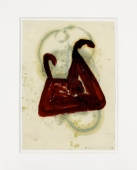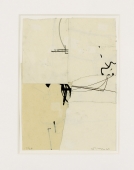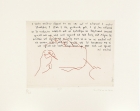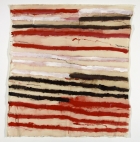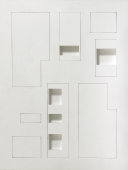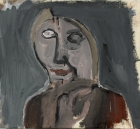
Artist | Georgia O'Keeffe (1887 - 1986)
Alias: Georgia O'Keeffe [Georgia O'Keefe]
https://www.artist-info.com/artist/Georgia-Okeeffe
Biography
Biography
American, born 1887
About the work (english)
About the work (english)
The pictures of Georgia O'Keeffe and Arthur Dove offer in an extremely sensitive manner a condensed discussion of the issues of the intemal relationship of humans to nature as well as issues of the meaning that the structural laws of nature have for humans. The photographer Alfred Stieglitz, later O'Keeffe's husband, had a strong impact on O'Keeffe and Dove. As early as 1905, Stieglitz maintained a photography gallery in the loft of # 291 Fifth A venue, and from 1907 it became an art gallery in which numerous famous European and later also American artists exhibited. Taking the texts of Henry David Thoreau as his starting point, and especially the latter's Walden, his ideas involved standing up for individualism and renouncing society as far as possible, in order to arrive at a more concrete notion of the world both alone and in accordance with the nature. Stieglitz and many artists who were his friends, saw Thoreau's book not only as a source of advice, but certainly also as a kind of philosophical compendium and a source of intellectual rejunevation and reason, Stieglitz was so enthusiastic about a series of charcoal drawings by O'Keeffe, which were presented to him in 1916, that he exhibited them immediately.
At this time, Georgia O'Keeffe, who for many people back then became the symbol of an independent, free and unorthodox woman, developed a very personal formal idiom derived from nature, which can be considered the equivalent of her own emotions. She did not want to abstract nature, but to produce symbols of nature's creative power, its laws and its sensuousness. With her pictures and drawings she formulated a world in which natural (organoid or geometric) forms were expressed in a lyrical mood and became the medium for poetic imagination. The early group of drawings displayed in Stieglitzs gallery included the charcoal drawing with the title Drawing No. 8 dating from 1915. It evidences many of the elements which are also of significance for the work of Mario Merz. In her early works, O'Keeffe developed a principle of visual concentration and approximation of motifs stemming from the vegetable or other area of nature, in order to fathom their many details and their specific structure. The drawings are kept in very dark hues which is based on a strong magnetism, called forth by a gaze into the interior of an organoid tube-like form that spirals into the depths. The motif of the spiral is to be found in nature in many plants and trees, and, again and again also in clouds and smoke formations. Because of the spiral shape a virtual movement towards the middle of the drawing arises and into an imaginary corporeal depth, equivalent to the location of the origin of life, growth and natural evolution. The innermost organic forms unleash associations in the viewer of birth and femininity. If one links the motif of the drawing in terms of motif and contents with the igloos of Merz, a key strand of meaning based on cosmic, universal contents, on structural laws, which revolve around the origin of the world and its mythical source, whereas the drawings can in a certain way be seen as a kind of prototype for development in natural laws, O'Keeffe's other works of the Twenties and Thirties show with large-scale and often highly ornamentalized vegetable and organic forms, some crystalline and others that are harmonious combinations of these formal poles.
In Flower Abstraction (1924) curved forms and finely lined limits in subtle shades are combined to create a body-like natural, and sensual composition which symbolizes fertilization, growth and being just as it describes symmetrical structures in nature.
In The White Calico Flower (1931) O'Keeffe directs our attention toward the delicate beauty of a cotton bud, which by dint of the formal means of abstracting simplification and enlargement becomes an aesthetic experience in its own right.
In Black and White (1930) color zones, reduced to abstract formal opposites and of differing expressive quality join to create a Formation that circumscribes the dualisms of the world by means of simple imagery. The principles of order (symbolized by a white wedge) and of disorder (artistically presented in the form of a cursorily implied, bent black swath of color, into which the white form presses) are depicted here in a very simple, but superbly precise and sensuous language. The picture expresses the harmonious balance of stasis and dynamism or geometry and organicism and thus refers, among others, to works by the Russian Constructivists as well as pictures by Wassily Kandinsky or Kasimir Malevich.
In Abstractions (1926), the composition is based on the tension of interwoven, fold-like zones in pastel colors. This offers the viewer a broad field of possible associations in respect of the meaning of natural models and structural laws.
The element of fluidity, of movement and transience is reflected in an abstract metaphorical way in the work It was Blue and Green, painted in 1960. Here, the composition foregrounds the imaginative power of the colors. Blue, river-like lines stream around a surface painted in different nuances of green, which, like a lake, seems to combine depth and surface. In this drawing, O'Keeffe in a more abstract way condenses vegetable and organic forms to a shaping of matter in the flow of time. Whereas Merz cites it by quoting T. S. Eliot in neon, here, the flow of time is described lyrically in a different, if comparable way.
About the work (deutsch)
About the work (deutsch)
Für O'Keeffe und Arthur Dove war der Fotograf Alfred Stieglitz, später Ehemann von O'Keeffe, von besonderer Bedeutung. Dieser führte bereits seit 1905 - in einer Dachkammer der Fifth Avenue Nr. 291 - zunächst eine Fotogalerie, ab 1907 dann eine Kunstgalerie, in der zahlreiche berühmte europäische und später auch amerikanische Künstler ausstellten. Auf den Texten und besonders auf dem Buch Walden oder Leben in den Wäldern von Henry David Thoreau aufbauend bekannte er sich zum Individualismus und forderte eine weitgehende Loslösung von der Gesellschaft, um allein und im Einklang mit der Natur zu einer konkreteren Weltvorstellung zu gelangen. Thoreaus Buch diente Stieglitz und vielen Künstlern, die mit ihm befreundet waren sicher auch als eine Art philosophisches Kompendium und Quelle geistiger Erneuerung und Besinnung. Stieglitz war im Jahr 1916 von einer Serie Kohlezeichnungen, die O'Keeffe gefertigt hatte, so begeistert, daß er sie sofort in seiner Galerie ausstellte.
Georgia O'Keeffe, die damals für viele Menschen zum Sinnbild einer unabhängigen, freien und unkonventionellen Frau wurde, entwickelte in dieser Zeit eine von der Natur abgeleitete Formensprache, die als Äquivalent ihrer Gefühlsregungen anzusehen ist. Sie wollte keine Abstraktionen nach der Natur, sondern Symbole ihrer Zeugungskraft, ihrer Gesetzmäßigkeiten und ihrer Sinnlichkeit schaffen. Mit ihren Bildern und Zeichnungen formulierte sie eine Welt, in der natürliche - organoide oder geometrische Formen in einem lyrischen Gefühl Ausdruck fanden und zu Trägern poetischer Phantasien wurden.
Zu der bereits erwähnten frühen Werkgruppe, die in Stieglitz' Galerie ausgestellt war, gehörte die Kohlezeichnung mit dem Titel Drawing No. 8 von 1915, in der sich Vorstellungen manifestieren, die auch für das Werk von Mario Merz von Bedeutung sind. Bereits in ihren frühen Arbeiten entwickelte O'Keeffe ein besonderes Prinzip der visuellen Konzentration und Annäherung an pflanzliche oder andere aus der Natur stammende Motive, um ihren Detailreichtum und ihre spezifische Struktur zu ergründen. Die sehr dunkel gehaltene Zeichnung vermittelt eine starke Sogwirkung, die durch den Blick in das Innere einer spiralförmig in die Tiefe verlaufenden, organoiden Röhrenform hervorgerufen wird. Aufgrund der Spiralform entsteht eine virtuelle Bewegung zur Mitte der Zeichnung und in eine imaginäre körperliche Tiefe hinein, die gleichbedeutend mit dem Ort der Entstehung von Leben, Wachstum und natürlichem Werden ist. Die organischen Formen setzen im Betrachter Assoziationen an die Gebärmutter einer Frau, an Geburt und Weiblichkeit frei. Das Spiralenmotiv als solches läßt sich in der Natur bei vielen Pflanzen und Bäumen aber auch bei Wolken- und Rauchformationen wiederfinden. Verbindet man das Motiv inhaltlich mit den Iglus von Merz, so konkretisiert sich ein beiden gemeinsamer zentraler Bedeutungsgehalt, der auf kosmischen, strukturalen Gesetzmäßigkeiten basiert, die um die Entstehung der Welt und ihren mythischen Ursprung kreisen. Läßt sich die Zeichnung in gewisser Weise als eine Art Prototyp naturgesetzlicher Entwicklung deuten, so zeigen andere Arbeiten von O'Keeffe, die in den zwanziger und dreißiger Jahren entstanden sind, in großflächigen und oft stark ornamentalisierten Formen Vegetabil-Organisches, Kristallines und verschiedene, mit diesen Formpolen komponierte harmonische Kombinationen.
In Flower Abstraction (1924) werden geschwungene Formen und feine lineare Begrenzungen in subtilen Farbtönen zu einer körperhaft-natürlichen, sinnlichen Komposition verbunden, die das Befruchten, Wachsen und Werden ebenso symbolisiert, wie sie symmetrische Strukturen in der Natur umschreibt.
In The White Calico Flower (1931) lenkt O'Keeffe unseren Blick auf die zarte Schönheit einer Baumwollblüte, die abstrahierend vereinfacht und extrem vergrößert wird.
In Black and White (1930) treffen zu abstrakten Formpolen reduzierte Farbzonen unterschiedlicher Ausdrucksqualität in einer Gestaltung zusammen, die die Dualismen der Welt als die Prinzipien der Ordnung - versinnbildlicht durch einen weißen Keil - und der Unordnung bildnerisch umgesetzt in Form eines schemenhaft angedeuteten, gebogenen schwarzen Farbschweifes, in den die weiße Form hineinstößt - beschreibt. Das Bild versinnbildlicht das harmonische Gleichgewicht von Statik und Dynamik oder von Geometrie und Organik und verweist damit auch auf Werke der russischen Konstruktivisten sowie auf Bilder von Wassily Kandinsky oder Kasimir Malewitsch.
In Abstraction (1926) baut die Bildkomposition auf einem Spannungsfeld aus ineinander verschachtelten, faltenartigen und in Pastelltönen gefärbten Farbzonen auf, die dem Betrachter ein breites Assoziationsfeld an Deutungen natürlicher Vorbilder und strukturaler Gesetze ermöglichen.
Das Moment des Fließens, der Bewegung und der Transitorik spiegelt sich in der Arbeit It was Blue and Green von 1960 wider. Hier steht die imaginative Kraft der Farbe im Vordergrund der Komposition. Blaue, flußähnliche Linienströme umfahren eine nuancenreiche grüne Fläche, die gleich einem See Tiefe und Fläche zu verbinden scheint. Der Fluß der Zeit, der in dem von Merz in Neonschrift zitierten Satz T. S. Eliot's formuliert wurde, findet hier eine andere, jedoch formal vergleichbare, lyrische Umschreibung.
German text by Rolf Lauter / Translation by Jeremy Gaines
(Extract - Full printed version available in the Museum)
MMK - Museum für Moderne Kunst, Frankfurt am Main
Internet
Internet
 offers / Requests offers / Requests  |
About this service |
|---|
 Exhibition Announcements Exhibition Announcements  |
About this service |
|---|
 Visualization |
Learn more about this service | ||
|---|---|---|---|

Interested in discovering more of this artist's networks?
3 easy steps: Register, buy a package for a visualization, select the artist.
See examples how visualization looks like for an artist, a curator, or an exhibition place: Gallery, museum, non-profit place, or collector.

Exhibition History

|
SUMMARY based on artist-info records. More details and Visualizing Art Networks on demand. Venue types: Gallery / Museum / Non-Profit / Collector |
||||||||||||
| Exhibitions in artist-info | 227 (S 56/ G 171) |
Did show together with - Top 5 of 3755 artists (no. of shows) - all shows - Top 100
|
||||||||||
| Exhibitions by type | 227: 52 / 141 / 30 / 4 | |||||||||||
| Venues by type | 112: 22 / 62 / 27 / 1 | |||||||||||
| Curators | 80 | |||||||||||
| artist-info records | May 1916 - Sep 2024 | |||||||||||
|
Countries - Top 5 of 14 United States (173) Germany (16) France (10) Italy (6) Switzerland (5) |
Cities - Top 5 of 58 New York (110) Washington DC (9) Santa Fe (7) Paris (6) Venezia (5) |
Venues (no. of shows )
Top 5 of 112
|
||||||||||
Curators (no. of shows)
Top 5 of 80
|
| Fondation Vincent van Gogh | G | Jun 2024 - Sep 2024 | Arles | (4) | +0 | |
| Loisy, Jean de (Curator) | +0 | |||||
| Curiger, Bice (Curator) | +0 | |||||
| The Fralin Museum of Art | S | Oct 2018 - Jan 2019 | Charlottesville | (5) | +0 | |
| Centre Pompidou - Metz | G | Apr 2018 - Aug 2018 | Metz | (27) | +0 | |
| Lavigne, Emma (Curator) | +0 | |||||
| Alison, Jane (Curator) | +0 | |||||
| Pitiot, Cloé (Curator) | +0 | |||||
| Biezunski, Elia (Curator) | +0 | |||||
| Princeton University Art Museum | G | Jan 2018 - Apr 2018 | Princeton | (10) | +0 | |
| Centre Pompidou - Metz | G | Mar 2017 - Aug 2017 | Metz | (27) | +0 | |
| Lavigne, Emma (Curator) | +0 | |||||
| Meisel, Hélène (Curator) | +0 | |||||
| Tate Britain | S | Jul 2016 - Oct 2016 | London | (118) | +0 | |
| Barson, Tanya (Curator) | +0 | |||||
| Johnston, Hannah (Curator) | +0 | |||||
| Keep reading |














